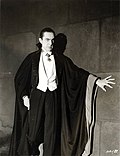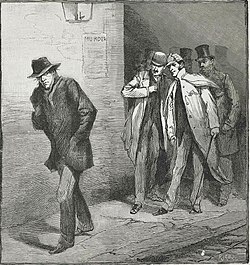Synopsis
The novel deviates from the events of Bram Stoker's Dracula . In this world, Vlad Tepes kills Abraham Van Helsing, and an injury sustained to Dr. John Seward's hand during a fight with Renfield means Van Helsing's allies lack the strength to defeat Dracula at the crucial moment. Instead, Dracula kills Quincey Morris and Jonathan Harker and completes Mina Harker's turning into a vampire. With no one to oppose him, Dracula creates thousands of British vampires, marries [1] and turns Queen Victoria (acquiring official royal status as Prince Consort) and ushers in a period of increasing British vampire domination. Dracula is well advanced in imposing a police state in the United Kingdom, where dissenters may be jailed or impaled without trial. Many of the country's leading scientists and intellectuals who choose to stay "warm" (including Sherlock Holmes) are imprisoned in concentration camps in the rural counties. The only two survivors of Van Helsing's group are Seward, who now runs a free clinic in Whitechapel, and Arthur Holmwood, Lord Godalming, who chooses to become a vampire and is groomed as a protégé by the new Prime Minister, Lord Ruthven.
Dieudonné has come down in the world, attending sick vampires in Seward's clinic. When another prostitute is murdered, Scotland Yard's Inspector Lestrade turns to them for an opinion. Beauregard, an agent of the Diogenes Club, is tasked with hunting down the killer, dubbed "Silver Knife" by the public, until an anonymous letter is delivered identifying him as "Jack the Ripper". The victim's inquest is attended by Lestrade, Dieudonné, and Beauregard, along with Captain Kostaki (an officer in Dracula's Carpathian Guard), and Dr. Henry Jekyll. Each sets out independently, with differing agendas. Separately, Lord Ruthven tasks Lord Godalming with heading an unofficial investigation to catch the killer.
Beauregard is abducted by an old enemy, a Tong leader who calls a truce on the understanding that the London underworld also has a strong interest in Silver Knife's capture. His official duties open a rift between him and his fiancée, Penelope Churchward (a cousin of his deceased first wife). In her zeal for social climbing, Penny urges Beauregard to agree that both of them will become vampires after their marriage.
Jack the Ripper strikes twice, failing to destroy one of his victims, Elizabeth Stride, who is brought to the clinic. Attempting to heal her wounds by shapeshifting, Stride does it imperfectly, lunging at Seward in her agony before dying. The implication is lost on Dieudonné and Beauregard, none of whom know that Seward, driven insane with grief over the loss of his love, Lucy Westenra, has taken to hunting vampires on his own. His murderous activities abate, temporarily, when he becomes infatuated with another prostitute, Mary Jane Kelly, who closely resembles Lucy.
During a temporary lull in the killings, Beauregard and Dieudonné, having similar ideas, become closer, while Penny is increasingly annoyed at Beauregard's lack of attention. In her haste, she allows Godalming to turn her, but the transformation is imperfect, and Penny almost dies, before Beauregard nurses her back to health with Dieudonné's help. Repulsed by the creature Penny has become, Beauregard ends their engagement and he and Dieudonné become lovers.
Public unrest escalates, with unclear causes. An anti-vampire leader is shot, and another of the Carpathian Guard is blown up with dynamite, both perhaps by the same mysterious vampire. Captain Kostaki and Scotland Yard Inspector Mackenzie form an unlikely alliance to find the culprit, but the mysterious vampire ambushes them, killing Mackenzie and disabling Kostaki with a silver bullet to his knee. Framed for Mackenzie's murder, Kostaki is imprisoned in the Tower of London, under the control of Graf Orlok. Lord Godalming questions Kostaki in secret, believing he has identified the Ripper as Sergeant Dravot, a vampire agent of the Diogenes Club. Eager to claim the credit for himself, Godalming leaves Kostaki to be condemned for Mackenzie's death. While following Dravot, alone, Godalming is aggravated by a "chance" meeting with his old friend, Seward, not realizing until too late that Seward is the real Ripper, who believes Godalming betrayed him and Lucy by becoming a vampire.
Beauregard and Dieudonné both realize that Seward is the Ripper. They race to Whitechapel and apprehend him, but not before he has killed both Kelly and Godalming. They leave the murder scene with Seward in custody, but then encounter Dravot, who admits to acting on the Diogenes Club's orders. These orders required him to kill Mackenzie, foment the riots, and stand by as Seward butchered Mary Jane Kelly. These orders also require there to be, officially, two Rippers: Seward and Godalming were working together before they fell out and Seward killed the other. Beauregard and Dieudonné are equally disgusted. When Seward points out that Dracula will turn him into a vampire so he can be tortured for all eternity, Beauregard kills him out of mercy.
When Beauregard confronts his superiors at the Diogenes Club, he asks why he was assigned to the case at all, since Dravot did all the actual work. He is told that Dravot, a vampire, could not be given the official credit for solving the murders, and it is necessary for Beauregard to carry out the final step of the plan.
Beauregard soon understands what this means when he and Dieudonné are invited to Buckingham Palace to be officially thanked by Queen Victoria for their role in catching the Ripper. Inside the palace, the two lovers confront Count Dracula, holding the turned Victoria as a prisoner. Knowing that neither of them can defeat Dracula in direct combat, Beauregard slips Seward's silver scalpel to Victoria, allowing her to kill herself, thus depriving Dracula of his status as Prince Consort and his legal authority over Great Britain. Before the vampires can retaliate, a riot breaks loose outside the Palace – possibly orchestrated by the club – and spills inside, allowing Beauregard and Dieudonné to escape and forcing Dracula to flee the country.




